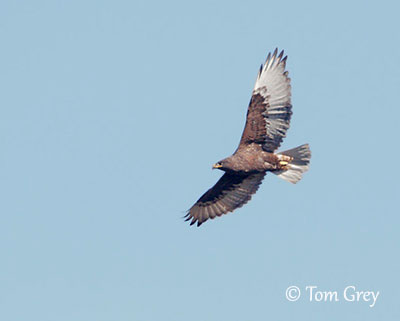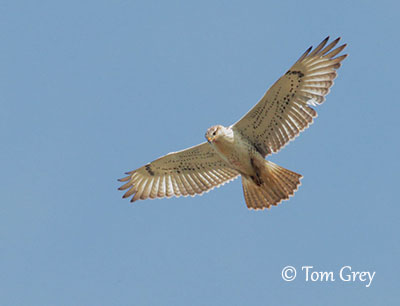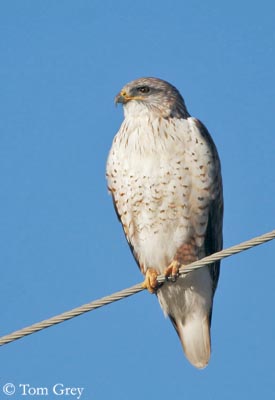
Ferruginous Hawk
Buteo regalis
Accipitriforme Order – Accipitridae Family
BIOMETRICS :
Length : 56-69 cm
Wingspan : 133-142 cm
Weight : 977-2074 g
LONGEVITY : Up to 20 years
DESCRIPTION:
Ferruginous Hawk is one of the three species of American Hawks to have feathered legs to toes. It is the largest American Hawk, with long and broad wings, large head and wide gape. It is an open country species, very similar to Golden Eagle (Aquila chrysateos) in food habits, flight, behaviour and calls.
All : Königsbussard
Esp : Busardo Herrumbroso
Ital : Poiana codarossa africana
Nd : Rosse Ruigpootbuizerd
Russe : Королевский канюк
Sd : Kungsvråk
Photographs by Tom Grey
His website:
Tom Grey's Bird Pictures
Text by Nicole Bouglouan
Sources:
HANDBOOK OF THE BIRDS OF THE WORLD Vol 2 by Josep del Hoyo-Andrew Elliot-Jordi Sargatal - Lynx Edicions - ISBN: 8487334156
A GUIDE TO THE BIRDS OF MEXICO AND NORTHERN CENTRAL AMERICA by Steve N. G. Howell, Sophie Webb - Oxford University Press - ISBN: 0198540124
FIELD GUIDE TO THE BIRDS OF NORTH AMERICA - National Geographic Society - ISBN: 0792274512
BIRDS OF THE GREAT BASIN – by Fred A. Ryser - Univ of Nevada Pr -ISBN: 0874170796
HAWKS, EAGLES AND FALCONS OF NORTH AMERICA by Paul A. Johnsgard - Smithsonian Institution Press - ISBN: 1560989467
Animal Diversity Web (University of Michigan Museum of Zoology)
Wikipedia (Wikipedia, The Free Encyclopedia)
What Bird-The ultimate Bird Guide (Mitchell Waite)

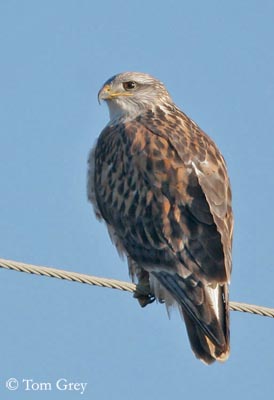
We can find two morphs in this species.
In light morph, adult has rusty brown upperparts, pale head and neck, and nearly white underparts. Legs are rusty and some rusty markings appear on the underwings and also on belly. Tail is white or grey. Seen from above, wings show a white area on extended primaries. Eyes are pale yellow. Bill is dark bluish to pearl grey, with yellow gape. Talons are yellow.
In dark morph, adult is dark brown on whole body, upperparts and underparts. Wings show a pale area on upper and lower primaries. Tail is greyish with deep brown on tail feathers. We can see some cinnamon feathers edges on throat, chest, sides and back. Eyes are pale brown to brown.
Both morphs present variations. Dark morph adult shows more or less dusky brown on belly. Light morph adult shows a varying quantity of ferruginous pigment and some grey across belly and on underwings.
A rufous morph may be seen, variably reddish throughout, mainly on underparts.
Both sexes are similar, with female larger than male and showing more dark markings on legs and belly.
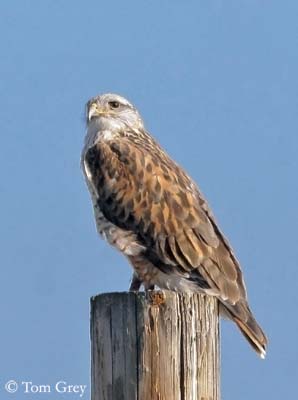
HABITAT:
Ferruginous Hawk breeds in grasslands and shrubby steppes. They avoid high elevations, forests and narrow canyons. They may be found in sparse riparian forests, canyons areas with cliffs and isolated trees, and small thickets in flat terrain.
They winter in open areas, from grasslands to deserts, where prairie-dogs are abundant.
RANGE:
Ferruginous Hawk is a breeding species in the arid West, from the southern end of the Canadian prairies provinces through the United States.
It winters from California and southern Nebraska, southwards to Central Mexico.
BEHAVIOUR:
Ferruginous Hawk hunts in varied manners. It may wait from a low perch or on the ground. When prey is detected, it launches itself with some wing beats, and then, it glides up to its prey. It also waits at the entrance of rodent burrows, or close to the recent works of a pocket gopher. It catches them when gother pushes the earth to the surface. The hawk spreads the wings, rises a few feet in the air, and comes down stiff-legged into the earth where its prey is transfixed and brought out.
Ferruginous Hawk performs aerial hunting by quartering back and forth, relatively close to the ground, with flapping flight, gliding and hovering. They also soar at higher elevations to detect preys.
In winter, we can see groups of up to 6 to 12 immature and adult hawks, hunting prairie-dogs from the ground.
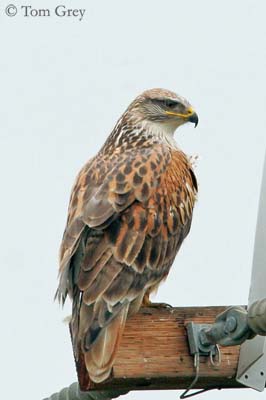
Sometimes, other eagles or hawks approach the site, flying at 7 to 10 metres from the ground. New arrivals threaten the hawks feeding on preys, by hopping and wing flapping, displacing them and creating a “feeding frenzy”. We don’t know if a hierarchy exists among Ferruginous Hawks at capture sites, but generally, eagles dominate the other raptors.
Ferruginous Hawk roosts on cliffs, human structures, trees and on the ground, singly or in pairs. We can find small groups of 6 to 12 birds together in winter. They sleep standing erect, sometimes on one leg, with closed eyes.
Ferruginous Hawk is aggressive during breeding season, chasing intruders away from territory, attacking them with open feet and talons grapping. When it is in aggressive posture, the hawk has held head upright and erected feathers on head, neck and breast. When it is threatened on the ground, it also holds the wings and has wide open bill. In the air, if there is an intruder, it performs buoyant flight displays, with deep and heavy wing beats, turning and performing undulating flight.
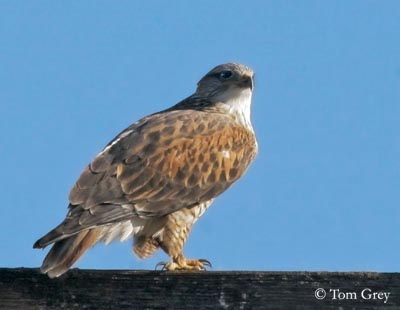
Ferruginous Hawk is probably monogamous, and pair bonds may be maintained year round. Courtship displays include flights, with both birds soaring in wide circles relatively high in the air. Male performs a kind of “fly-dancing”, with slow, deep, laboured wing beats, and irregular yawing and pitching. It dives and ascends often, close to the female from above, extends its legs and briefly grasps female. Both birds often may grasp each others beaks and talons, while spiralling towards the ground, screaming and calling.
Copulation may occur after flight displays, but also after nest-building and male may performs courtship-feeding, bringing food to female throughout courtship period.
Ferruginous Hawk harasses, chases and attacks near nest other raptors which may prey on young.
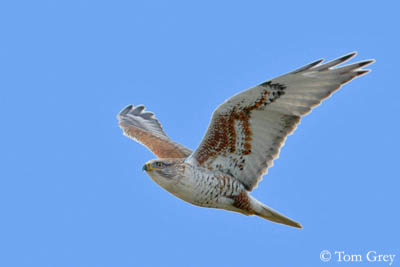
FLIGHT:
Ferruginous Hawk flies low to the ground when hunting. It also can perform dynamic soaring, rising several hundreds metres and then falling steeply to a few metres from the ground.
REPRODUCTION:
Ferruginous Hawk pair visits nests from previous years, and mates share nest-site selection. They may nest in trees, shrubs, cliffs, human structures or on the ground (slopes, crests of ridges).
Nest may be located from the ground to 20 metres above or higher in human structures. Nest is built or refurbished by both adults. Male brings materials to female which arranges them, forming nest cup. They need about one week for this work. Nest-building takes part in pair-bonding.
Nest is made with twigs, sticks, stems and debris found on the ground. Female may line the cup with chips of bark. They may add bones and cow dung. In some regions, cup is lined with dung and grass. Sometimes, female includes paper, barbed wire, plastic…
Nest material used by Ferruginous Hawks reflects its habitat. Birds use materials according to that available around the nest-site.
Female lays 2 to 4 smooth creamy-white eggs, spotted with pale to dark browns and buffs. Eggs seem to be laid at two days intervals. Incubation starts with the first egg laid, and lasts about 32 to 33 days. Female incubates more than male. Male perches and patrols near the nest. Nest is always attended. Female is fed by male which provides food to the nest.
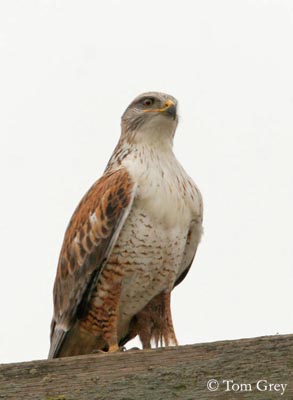
Altricial chicks hatch over 2 to 4 days. They have closed eyes and wet down. They can’t raise their heads and lie or sit at about two weeks of age. They stand at 18 to 20 days, and may walk soon after. They are fed by both parents, male brings prey and female gives them.
Young can eat small items themselves at about 16 to 18 days. At about 33 to 34 days of age, they can flap their wings and make flap-jumps.
Siblicide may occur but it is apparently rare.
Female broods the young for the first three weeks. Its detachment is gradual. As young are growing, she perches on edges of the nest in a nearby tree. Young leave the nest at about 38 to 50 days. They remain within 100 to 200 metres from the nest, perching on trees, elevated perches or on the ground.
They are able to kill prey at 52 days of age, but young remain dependent on parents for several weeks more. Their early flights are short and clumsy.
This species produces only one brood per season.
DIET:
Ferruginous Hawk feeds mainly on small rodents such as prairie-dogs, ground-squirrels, rabbits and hares.
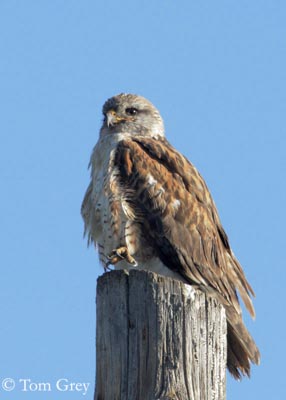
PROTECTION / THREATS / STATUS:
Ferruginous Hawk may be killed in wintering areas, but also by collisions with power-lines wires or cars. Human disturbances are linked to nest desertion, such as research activities, which alter the nesting behaviour.
Habitat loss is an important fact in some declines, as poisoning and controlling small rodents’ populations, and fire in nesting habitats.
Artificial nest platforms are useful in increasing populations when trees have dead and fallen.
Juvenile in light morph has immaculate white underparts, with a pale rufous bloom on chest of young fledged birds. Upperparts show some ferruginous or orange-cinnamon. Tail is grey with white basal areas, and indistinct subterminal dark band.
Juvenile in dark morph has entire dark brown body and wing coverts. Breast may be tinged rufous. Tail presents faint dark bands. Eyes are brown yellow. Bill is black. Tarsi and toes are dull yellow.
VOICE: SOUNDS BY XENO-CANTO
Ferruginous Hawk is vocal during breeding season, and mainly during flight displays. It is very quiet during winter, even in small groups of up to 10 to 12 birds.
Alarm call is a scratchy “kree-a” and a harsh “kaah kaah”, almost similar to the Herring Gull’s call. These alarm calls seems to be weak and plaintive.
Young at nest utter cheeping sounds, and fledglings utter the same adult’s sounds.
